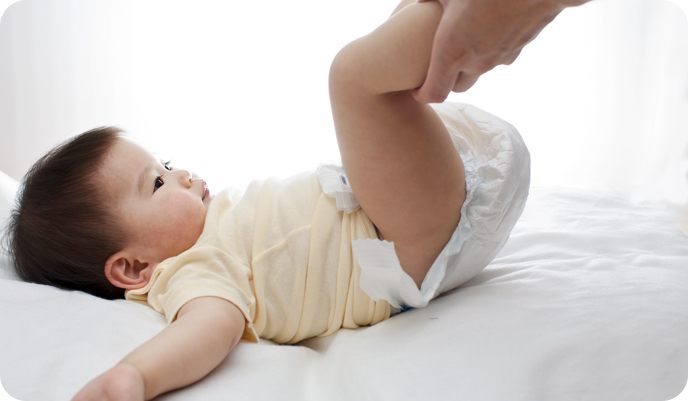Parenting is full of unexpected moments, especially for first-time parents - one of these might be inspecting your baby’s poo on a daily basis! You may even find yourself researching the meaning of different colours or consistencies of baby poo on more than one occasion.
Nappy changes are an important part of any parent’s daily routine and they can also be an important way to keep an eye on your baby’s health.The contents of your baby’s nappy can change day to day or week to week, in terms of colour, consistency, and the amount they produce.
With so much information out there, it can be hard to tell what’s normal so we’ve produced the ultimate guide to baby poo.

YOUR BABY’S FIRST POO
Your baby’s first poo is called meconium and it is already in their bowel once they’re born. Meconium can often shock parents if they’re aren’t aware of it, due to the unusual black or dark green colour. This first poo also has a thicker, stickier consistency and is often difficult to clean off your new baby’s bottom!
Have no fear of this first poo, it’s completely normal for this first nappy change to be a little shocking. The first poo looks a little different as your baby is getting rid of any ingested amniotic fluid.
Meconium can appear during the first 48 hours, but just to be on the safe side, if your baby doesn’t have a bowel movement in their first 24 hours, then let your doctor or healthcare visitor know.
TRANSITIONAL STOOLS
After the meconium has passed, on day 3 or 4 your baby’s poo will change colour. It will begin to look greener and will become looser. This happens because your baby is taking in and digesting more milk. The transitional stool is a combination of meconium and the next phase of poo called milk stools. Although it can be quite surprising the first time you see green poo, it’s completely normal!
MILK STOOLS
Your child should no longer have meconium in their body after day six and they will begin to have milk stools. During this phase, a baby’s poo will also vary depending on whether they are formula-fed or breast-fed.
If you are breastfeeding, the colour of your little one’s poo will often be a mustard yellow colour, but it can vary from orange to green. Your baby’s bowel movements during this phase are likely to be loose, with a mild odour and they may contain curds of milk, called seeds.
If you are using infant formula, your child's poo will be firmer with a stronger odour and the colour is likely to be shades of tan to brown.

HOW DOES YOUR BABY’S POO CHANGE WHEN WEANING?
When you start introducing solid foods (at around 6 months) you’ll start to see and smell some major changes in your baby’s nappy, particularly if you were breastfeeding before. Solid food poo tends to be thicker, stronger smelling and darker in colour, but this can change depending on the food your baby is eating.
Weaning your baby onto solid foods is a common trigger of nappy rash; this is where Metanium Everyday Barrier Ointment can really come in handy during nappy changes to help protect your little one’s skin.
THE COLOUR OF YOUR BABY’S POO
Although it may be a surprise to open your little one’s nappy to something you weren’t expecting, variations in the colour of your baby’s poo is normal. However, in a few cases, certain colors can be a sign of possible health or digestion problems. You should always check with your doctor if your baby’s poo is:
- Black: After the meconium period is over, black poo could in some cases indicate bleeding in the digestive tract. Certain foods, such as blueberries, could also be the cause of this so try not to panic until you’ve spoken to your GP or health visitor.
- Red: Red poo could mean there’s blood in your baby’s bowel movements, so it’s important to check with your GP. Again, this can also be caused by foods and drinks they have consumed, so always get in touch with a healthcare professional if you see this change in colour.
- White, grey, or colourless: Although rare, this could be a sign of a problem with the liver or gallbladder. White poop could indicate that your baby isn’t producing enough bile in their liver to help them digest food properly, so make sure to keep note of this and speak to your GP or health care visitor.

HOW TO TELL IF YOUR BABY IS CONSTIPATED
Constipation makes it more difficult for your baby to poo and can be caused by diet, including a change in your baby’s diet, or a lack of fibre in their diet. It can also be caused by dehydration which could be due to an illness such as a cold.
Symptoms of constipation to look out for in your baby can include:
- Finding it difficult to poo
- Poos that are larger than usual
- Dry, hard, lumpy or pellet-like poos
- Unusually smelly wind and poo
- Your baby may be less hungry than usual
- Their tummy might feel firm
- Pooing fewer than 3 times in a week
There’s no ‘normal’ when it comes to how often babies poo, but you’ll quickly get used to your little one’s bowel movements so you’ll be able to tell what’s normal for them.
Here are a few tips to help treat constipation if you think your little one may be struggling:
- If your little one is eating solid foods, make sure they have enough fibre in their diet to help loosen their stools. Food such as vegetables, fruits and cereals are great options.
- If your baby is bottle-fed, try giving your baby extra water in between feeds to help prevent dehydration.
- Try lying your baby down and gently moving their legs to get things moving.
It may take a few days to see any movement, but if you don’t see things improve, make sure to speak with your health visitor or GP.

DIARRHOEA IN BABIES
It’s not unusual for breastfed babies to pass looser stools. However, if your baby’s poo seems watery, especially if those bowel movements suddenly start coming more frequently, your little one may have diarrhoea. If your baby does have diarrhoea, it's likely caused by a viral infection. However, there are a few other possible causes such as food poisoning or allergies.
Diarrhoea will normally get better within a few days, but sometimes it can be a sign of an infection that needs treating. Plus, babies who have diarrhoea are also more likely to suffer from dehydration, so let your GP know if you suspect your baby has diarrhoea and make sure that they get enough fluids in the meantime.
Diarrhoea is a common trigger of nappy rash due to your little one’s nappy being wetter than usual. Thankfully, Metanium Everyday Barrier Ointment is the perfect nappy changing essential to help protect your little one’s skin from nappy rash at every change.
Well, bet you didn’t think there was so much to learn about your baby’s poo! But don’t worry, although there’s a lot to take in, you’re the expert when it comes to your little one’s bowel movements. Trust your own instincts when it comes to checking their nappy contents.
For more helpful nappy time tips, read our guide to changing a baby’s nappy or head to our Facebook or Instagram page to share your parenting tips!
Related posts
Metanium Nappy Rash Ointment is a medicine. Always read the label.




